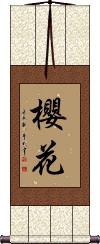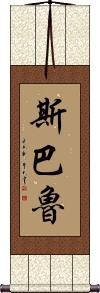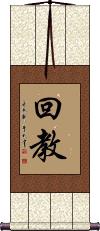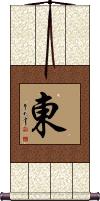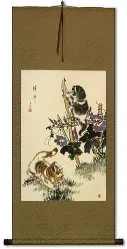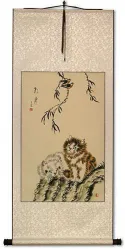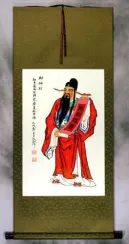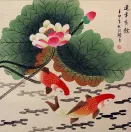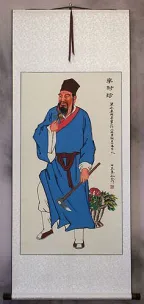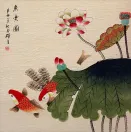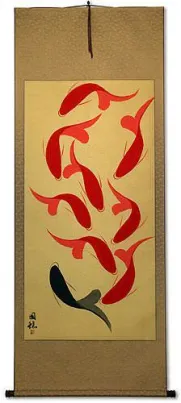Many custom options...
And formats...

Oriental in Chinese / Japanese...
Buy an Oriental calligraphy wall scroll here!
Personalize your custom “Oriental” project by clicking the button next to your favorite “Oriental” title below...
Asian Pride / Oriental Pride / AZN Pryde
東方自尊 is the universal way to write “Asian Pride.”
We worked on this one for a long time. The effort involved both Chinese and Japanese translators and lengthy discussions. If you have been searching for this term, there is a reason that it's hard to find the way to write “Asian Pride” in Chinese and Japanese - it's because of the inherent difficulties in figuring out a universal combination of characters that can be read in all languages that use forms of Chinese characters.
This final solution that you see to the left creates a reasonable title in Chinese and an exotic (perhaps unusual) title in Japanese (This could be read as “Eastern Self-Respect” in Japanese”).
Although not as natural, it does have the same meaning as Korean Hanja, and the older generation of Vietnamese people will be able to read it.
The first two characters literally mean “Oriental” and the second two mean “pride,” “self-esteem,” or “self-respect” (we chose the most non-arrogant way to say “pride”). If you have “Asian Pride” (sometimes spelled Asian Pryde) these are the characters for you.
Note: For those who wonder, there is nothing technically wrong with the word “Oriental.” It is a correct word, and any bad meanings were created by so-called “Asian Americans” and Caucasians in the United States. To say “Asian” would not completely correct the intended meaning since that would include people from Saudi Arabia, Iraq, Iran, India, and portions of Russia.
For further proof, if you were of East Asian ancestry and born in England, you would be known as a “British Oriental” (The “Oriental stigma” is basically an American creation and, therefore, applies mainly to the American English language - where they get a bit overzealous with political correctness).
Further, since the Chinese and Japanese word for Oriental is not English, they can not be construed as having ill meaning. On one trip to China or Japan, you will find many things titled with these two characters, such as malls, buildings, and business names. These places also use “Oriental” as their English title (much as we do since our Chinese business name starts with these same two characters).
In short, the first two characters have the meaning that Americans attach to “Asian” but is more technically correct.
Cherry Blossom
櫻花 is how to write “cherry blossom” in Chinese and traditional Japanese Kanji.
The first character means “cherry” or sometimes “cherry tree.”
The second character means “flowers” or “blossoms.”
Oddly, my Chinese dictionary also defines these two characters as “Japanese oriental cherry tree” or “Oriental cherry blossom.” However, the first character is the only one that means “cherry,” so it can refer to any cherry blossoms in the whole world (not just those in Asia).
![]() There is an alternate version of the first character, which has become the standard for Japanese Kanji. If you want this version, instead of the one shown to the upper left, please click on the Kanji shown to the right instead of the button above. Although this is an alternate form in Chinese, most Chinese people will think this is just the Japanese version (Chinese people
don’t
necessarily know the history and all alternate forms of Chinese characters from the past). Therefore, this version shown to the right is best if your audience is Japanese (though most Japanese will recognize the form shown in the upper left).
There is an alternate version of the first character, which has become the standard for Japanese Kanji. If you want this version, instead of the one shown to the upper left, please click on the Kanji shown to the right instead of the button above. Although this is an alternate form in Chinese, most Chinese people will think this is just the Japanese version (Chinese people
don’t
necessarily know the history and all alternate forms of Chinese characters from the past). Therefore, this version shown to the right is best if your audience is Japanese (though most Japanese will recognize the form shown in the upper left).
Subaru
Islam
The religion of the Hui People
回教 means “Hui Religion” in Chinese.
It refers specifically to the Hui people (Huizu), who have typical Oriental looks but are Muslim (practice the religion of Islam). Hui people can be found throughout China, often establishing Muslim neighborhoods in many cities.
My Japanese dictionary lists this as the all-Kanji way to write Islam as well.
In Korean, the first character is used as a short name to say Muslim.
East
東 is the direction East in Chinese, Japanese Kanji, and old Korean Hanja.
Sometimes used as an abbreviation for the Eastern Hemisphere.
This can also be the surname Dong in China.
In Japan, this can be an abbreviation for a kind of six-stringed zither, or the personal name, Yamato.
東 is used as a suffix for many words in Asia. In fact, it's part of the CJK word 東方 meaning Orient or Oriental. The word 東方 more literally translates as “Eastern Kingdoms,” “Eastern Countries,” or simply “The East.”
This in-stock artwork might be what you are looking for, and ships right away...
Gallery Price: $60.00
Your Price: $36.88
Shen Nong
Divine Farmer
Oriental Wall Scroll
Discounted Blemished
Gallery Price: $58.00
Your Price: $32.00
Gallery Price: $286.00
Your Price: $158.88
Gallery Price: $160.00
Your Price: $88.88
Not the results for oriental that you were looking for?
Below are some entries from our dictionary that may match your oriental search...
| Characters If shown, 2nd row is Simp. Chinese |
Pronunciation Romanization |
Simple Dictionary Definition |
櫻花 樱花 see styles |
yīng huā ying1 hua1 ying hua sakura さくら |
More info & calligraphy: Cherry Blossom(female given name) Sakura |
佩 see styles |
pèi pei4 p`ei pei hai はい |
to respect; to wear (belt etc) (1) ancient oriental belt decoration; (suf,ctr) (2) counter for swords to wear; put on; wrap around |
柚 see styles |
yòu you4 yu yuni ゆに |
pomelo (Citrus maxima or C. grandis); shaddock; oriental grapefruit (out-dated or obsolete kana usage) (kana only) yuzu (Citrus ichangensis x C. reticulata); (female given name) Yuni |
椋 see styles |
liáng liang2 liang ryou / ryo りょう |
used in 椋鳥|椋鸟[liang2 niao3] (kana only) Aphananthe oriental elm (Aphananthe aspera); mukutree; (female given name) Ryō |
珮 佩 see styles |
pèi pei4 p`ei pei hai はい |
girdle ornaments ancient oriental belt decoration |
螻 蝼 see styles |
lóu lou2 lou kera けら |
see 螻蛄|蝼蛄[lou2 gu1] (kana only) mole cricket (esp. the Oriental mole cricket, Gryllotalpa orientalis); (surname) Kera |
鮎 鲇 see styles |
nián nian2 nien nen ねん |
sheatfish (Parasilurus asotus); oriental catfish; see also 鯰|鲶[nian2] (kana only) sweetfish (Plecoglossus altivelis altivelis); ayu; (personal name) Nen |
鯰 鲶 see styles |
nián nian2 nien namazu なまず |
sheatfish (Parasilurus asotus); oriental catfish; see also 鮎|鲇[nian2] (1) (kana only) catfish (esp. the Amur catfish, Silurus asotus); (2) (archaism) earthquake; (surname) Namazu |
鸛 鹳 see styles |
guàn guan4 kuan kounotori; kou; kounotori / konotori; ko; konotori こうのとり; こう; コウノトリ |
crane; stork (kana only) stork (esp. the Oriental stork, Ciconia boyciana) |
三椏 see styles |
mitsumata; mitsumata みつまた; ミツマタ |
(kana only) Oriental paper bush (Edgeworthia chrysantha); mitsumata |
大根 see styles |
daikon だいこん |
(noun - becomes adjective with の) (1) daikon (variety of large white Oriental radish, Raphanus sativus var. longipinnatus); (noun - becomes adjective with の) (2) (abbreviation) (See 大根役者) ham actor; (female given name) Daikon |
山鳩 see styles |
yamabato やまばと |
(1) mountain-dwelling dove; (2) (See キジバト) Oriental turtle dove; rufous turtle dove; (3) (See アオバト) white-bellied green pigeon; (surname) Yamabato |
敬語 敬语 see styles |
jìng yǔ jing4 yu3 ching yü keigo / kego けいご |
honorific (e.g. in grammar of oriental languages) {ling} honorific; term of respect; polite expression; honorific language |
東邦 see styles |
touhou / toho とうほう |
Oriental country; the Orient; (surname) Tōhou |
柚子 see styles |
yòu zi you4 zi5 yu tzu yuzuko ゆずこ |
pomelo (Citrus maxima or C. grandis); shaddock; oriental grapefruit (kana only) yuzu (Citrus ichangensis x C. reticulata); (female given name) Yuzuko |
柚木 see styles |
yòu mù you4 mu4 yu mu yunoki ゆのき |
pomelo tree (Citrus maxima or C. grandis); shaddock; oriental grapefruit (place-name, surname) Yunoki |
栗鴞 栗鸮 see styles |
lì xiāo li4 xiao1 li hsiao |
(bird species of China) oriental bay owl (Phodilus badius) |
椋木 see styles |
ryouki / ryoki りょうき |
(kana only) Aphananthe oriental elm (Aphananthe aspera); mukutree; (surname) Ryōki |
槲櫟 槲栎 see styles |
hú lì hu2 li4 hu li |
oriental white oak (Quercus aliena) |
樸樹 see styles |
mukunoki むくのき |
(kana only) Aphananthe oriental elm (Aphananthe aspera); mukutree |
水蕨 see styles |
mizuwarabi; mizuwarabi みずわらび; ミズワラビ |
(kana only) water sprite (Ceratopteris thalictroides); Indian fern; water fern; Oriental waterfern; water hornfern |
清白 see styles |
qīng bái qing1 bai2 ch`ing pai ching pai seihaku / sehaku せいはく |
pure; innocent (obscure) daikon (variety of large white Oriental radish, Raphanus sativus var. longipinnatus) (primarily used in context of the seven spring herbs); (given name) Seihaku |
猛隼 see styles |
měng sǔn meng3 sun3 meng sun |
(bird species of China) oriental hobby (Falco severus) |
甜瓜 see styles |
tián guā tian2 gua1 t`ien kua tien kua tenka; makuwauri(gikun); tenka てんか; まくわうり(gikun); テンカ |
muskmelon (See マクワウリ) Oriental melon (Cucumis melo var. Makuwa) |
筒鳥 see styles |
tsutsutori つつとり |
(kana only) Oriental cuckoo (Cuculus saturatus); (surname) Tsutsutori |
紙魚 纸鱼 see styles |
zhǐ yú zhi3 yu2 chih yü shimi しみ |
silverfish (Lepisma saccarina); fish moth (gikun reading) (1) (kana only) true bristletail (any insect of order Thysanura, esp. of family Lepismatidae); (2) Oriental silverfish (Ctenolepisma villosa); (3) (derogatory term) someone who is unable to apply what they have read |
綠雀 绿雀 see styles |
lǜ què lu:4 que4 lü ch`üeh lü chüeh |
oriental greenfinch (Carduelis sinica) |
胡弓 see styles |
koyumi こゆみ |
(1) kokyu (3 or 4-stringed bowed Japanese musical instrument); (2) any Oriental string instrument played with a bow; (personal name) Koyumi |
胡琴 see styles |
hú qin hu2 qin5 hu ch`in hu chin kokin こきん |
huqin; family of Chinese two-stringed fiddles, with snakeskin covered wooden soundbox and bamboo bow with horsehair bowstring (1) huqin (any Chinese string instrument played with a bow); (2) (archaism) (See 琵琶) biwa (4 or 5-stringed Oriental lute) |
草蝦 see styles |
tenagaebi てながえび |
freshwater prawn (Macrobrachium spp., esp. the Oriental river prawn, Macrobrachium nipponense) |
Click here for more oriental results from our dictionary
The following table may be helpful for those studying Chinese or Japanese...
| Title | Characters | Romaji (Romanized Japanese) | Various forms of Romanized Chinese | |
| Asian Pride Oriental Pride AZN Pryde | 東方自尊 东方自尊 | tou hou zi son touhouzison to ho zi son | dōng fāng zì zūn dong1 fang1 zi4 zun1 dong fang zi zun dongfangzizun | tung fang tzu tsun tungfangtzutsun |
| Cherry Blossom | 櫻花 樱花 / 桜花 | ouka / oka | yīng huā / ying1 hua1 / ying hua / yinghua | |
| Subaru | 斯巴魯 斯巴鲁 | sī bā lǔ si1 ba1 lu3 si ba lu sibalu | ssu pa lu ssupalu |
|
| Islam | 回教 | kai kyou / kaikyou / kai kyo | huí jiào / hui2 jiao4 / hui jiao / huijiao | hui chiao / huichiao |
| East | 東 东 | higashi / tou higashi / to | dōng / dong1 / dong | tung |
| In some entries above you will see that characters have different versions above and below a line. In these cases, the characters above the line are Traditional Chinese, while the ones below are Simplified Chinese. | ||||
Successful Chinese Character and Japanese Kanji calligraphy searches within the last few hours...

